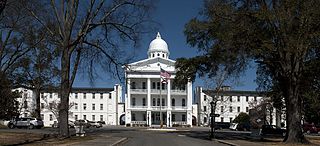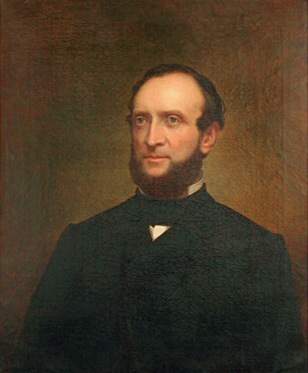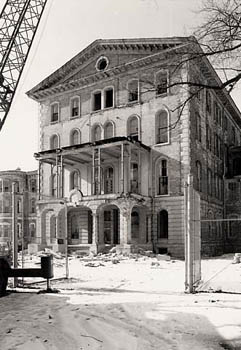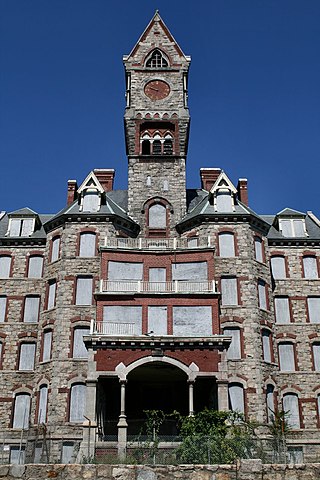
Madison is the capital city of the state of Wisconsin and the county seat of and largest city in Dane County. As of the 2020 census, the population was 269,840, making it the second-most populous city in Wisconsin after Milwaukee, and the 80th-most populous in the United States. Madison is named for American Founding Father and President James Madison.

Fort Atkinson is a city in Jefferson County, Wisconsin, United States. It is on the Rock River, a few miles upstream from Lake Koshkonong. The population was 12,579 at the 2020 census. Fort Atkinson is the largest city located entirely in Jefferson County, as Watertown is split between Jefferson and Dodge counties. Fort Atkinson is a principal city of the Fort Atkinson-Watertown micropolitan statistical area which is in turn a sub-market of the larger Milwaukee-Waukesha-Racine CSA.

Bryce Hospital opened in 1861 in Tuscaloosa, Alabama, United States. It is Alabama's oldest and largest inpatient psychiatric facility. First known as the Alabama State Hospital for the Insane and later as the Alabama Insane Hospital, the building is considered an architectural model. The hospital houses 268 beds for acute care, treatment and rehabilitation of full-time (committed) patients. The Mary Starke Harper Geriatric Psychiatry Hospital, a separate facility on the same campus, provides an additional 100 beds for inpatient geriatric care. The main facility was added to the National Register of Historic Places in 1977.

Leonard James Farwell was an American politician and public administrator. He was the 2nd Governor of Wisconsin.

An effigy mound is a raised pile of earth built in the shape of a stylized animal, symbol, religious figure, human, or other figure. The Effigy Moundbuilder culture is primarily associated with the years 550–1200 CE during the Late Woodland Period, although radiocarbon dating has placed the origin of certain mounds as far back as 320 BCE.

The Cherokee Mental Health Institute is a state-run psychiatric facility in Cherokee, Iowa. It opened in 1902 and is under the authority of the Iowa Department of Human Services.

Florida State Hospital (FSH) is a hospital and psychiatric hospital in Chattahoochee, Florida. Established in 1876, it was Florida's only state mental institution until 1947. It currently has a capacity of 1,042 patients. The hospital's current Administration Building is on the National Register of Historic Places.

The Wisconsin Department of Corrections (WIDOC) is an administrative department in the executive branch of the state of Wisconsin responsible for corrections in Wisconsin, including state prisons and community supervision. The secretary is a cabinet member appointed by the governor of Wisconsin and confirmed by the Wisconsin Senate.

Henryton State Hospital is a now-demolished hospital complex in Marriottsville, in southern Carroll County, Maryland, just across the Howard County line. The complex was located within Patapsco Valley State Park and along its southern end runs CSX's Old Main Line Subdivision and is very close to the Henryton Tunnel. The Henryton State Hospital center, or the Henryton Tuberculosis Sanatorium as it was called, was erected in 1922 by the Maryland Board of Mental Hygiene. It was established as a facility to treat African Americans suffering from tuberculosis. This was one of the first such facilities in Maryland erected to provide African Americans with the same level of treatment as white people. Other accounts state that this was more of containment Hospital rather than a treatment facility. They contend that Henryton was used more for the exile and quarantine of tuberculosis patients.

The Elgin Mental Health Center is a mental health facility operated by the State of Illinois in Elgin, Illinois. Throughout its history, Elgin's mission has changed. At times, it treated mental illness, tuberculosis, and provided federally funded care for veterans. The hospital's site, which included a patient-staffed farm reached a maximum of 1,139 acres (461 ha) after World War II. Its maximum population was reached in the mid 1950s with 7,700 patients. Between 1993 and 2008, most of the older buildings in the complex were demolished due to being in poor condition as the result of being abandoned for decades. The site is/was popular among teens and in the paranormal world due to its claims of hauntings in the older buildings and the hospital's cemetery.

The Utah State Hospital (USH) is a mental hospital located in eastern Provo, Utah. The current superintendent is Dallas Earnshaw.

The Topeka State Hospital was a publicly funded institution for the care and treatment of the mentally ill in Topeka, Kansas, in operation from 1872 to 1997. Located at 2700 W 6th Street, the hospital opened in 1879, after the Osawatomie State Hospital, once thought to be sufficient, became overcrowded with mentally-ill patients.

Worcester State Hospital was a Massachusetts state mental hospital located in Worcester, Massachusetts. It is credited to the architectural firm of Weston & Rand. The hospital and surrounding associated historic structures are listed as Worcester Asylum and related buildings on the National Register of Historic Places.

Winnebago Mental Health Institute (WMHI), formerly the Winnebago State Hospital, is a psychiatric hospital near Oshkosh, Wisconsin, United States located in the unincorporated community of Winnebago, Wisconsin.
The Mount Pleasant Mental Health Institute was a psychiatric institution located in Mount Pleasant, Iowa, USA. Originally known as the Iowa Lunatic Asylum, it opened in 1861. It is located on the same campus as The Mount Pleasant Correctional Facility. There was also a labyrinth of tunnels which connected every building. It was the first asylum in Iowa and was built under the Kirkbride Plan.

The Independence State Hospital was built in 1873 as the second asylum in the state of Iowa. It is located in Independence, Iowa. The original plan for patients was to relieve crowding from the hospital at Mount Pleasant and to hold alcoholics, geriatrics, drug addicts, mentally ill, and the criminally insane. It was built under the Kirkbride Plan. The hospital's many names include: The Independence Lunatic Asylum, The Independence State Asylum, The Independence Asylum for the Insane, The Iowa State Hospital for the Insane, and The Independence Mental Health Institute. There is also a labyrinth of tunnels which connect every building. Like most asylums of its time, it has had a gruesome and dark history. Remnants of this are the graveyard, hydrotherapy tubs, and lobotomy equipment.
Johann "John" Fellenz was a German American immigrant, building contractor, and Wisconsin pioneer. He was a member of the Wisconsin State Assembly, representing the southwest side of the city of Milwaukee for five terms. He was also one of the contractors for the construction of the Winnebago Mental Health Institute.
Glenside Hospital, as it was known from 1967, previously the Public Colonial Lunatic Asylum of South Australia, Parkside Lunatic Asylum and Parkside Mental Hospital, was a complex of buildings used as a psychiatric hospital in Glenside, South Australia.

The Racine County Insane Asylum was a mental hospital, operated by the County of Racine, Wisconsin, from 1889 to the 1970s.

Mendota Juvenile Treatment Center (MJTC) is a juvenile psychiatric facility of the Wisconsin Department of Health Services, located in the Lorenz Hall Annex on the grounds of the Mendota Mental Health Institute (MMHI) in Madison, Wisconsin. It has space for 29 patients. The inmates at Mendota usually have anti-social personality disorders who do not feel empathy, guilt, nor remorse. It uses the Mendota Juvenile Treatment Center Program.

























